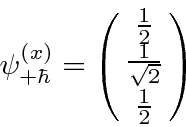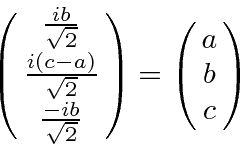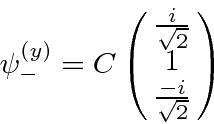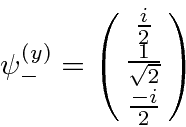Next: Energy Eigenstates of an Up: Examples Previous: Eigenvectors of Contents
If we rotate our coordinate system by 90 degrees about the z axis,
the old x axis becomes the new -y axis.
So we would expect that the state with angular momentum
 in the x direction,
in the x direction,
 ,
will rotate into
,
will rotate into
 within a phase factor.
Lets do the rotation.
within a phase factor.
Lets do the rotation.



The rotated state is.

Now, what remains is to check whether this state is the one we expect.
What is
 ?
We find that state by solving the eigenvalue problem.
?
We find that state by solving the eigenvalue problem.



Setting
![]() , we get the unnormalized result.
, we get the unnormalized result.


 into
into
 .
.
Jim Branson 2013-04-22